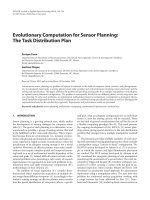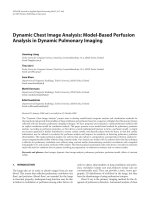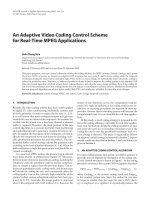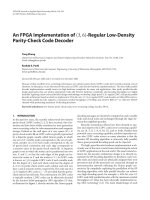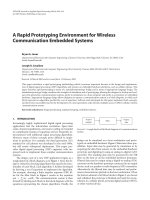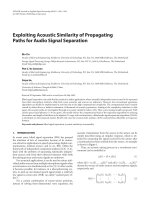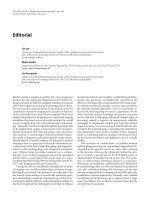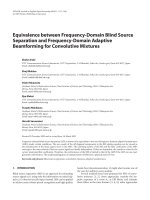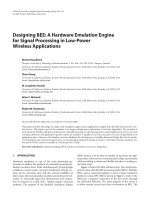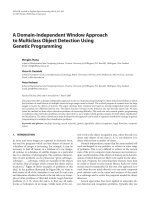EURASIP Journal on Applied Signal Processing 2003:8, 733–739 c 2003 Hindawi Publishing doc
Bạn đang xem bản rút gọn của tài liệu. Xem và tải ngay bản đầy đủ của tài liệu tại đây (581.98 KB, 7 trang )
EURASIP Journal on Applied Signal Processing 2003:8, 733–739
c
2003 Hindawi Publishing Corporation
Editorial
Riccardo Poli
Department of Computer Science, University of Essex, Wivenhoe Park, Colchester, CO4 3SQ, UK
Email: rpoli@esse x.ac.uk
Stefano Cagnoni
Depar tment of Computer Engineering, University of Parma, 43100 Parma, Italy
Email:
1. INTRODUCTION
Darwinian evolution is probably the most intriguing and
powerful mechanism of nature mankind has ever discov-
ered. Its power is evident in the impressive level of adapta-
tion reached by all species of animals and plants in nature. It
is intriguing because despite its simplicity and randomness,
it produces incredible complexity in a way that appears to
be very directed, almost purposeful. Like for other powerful
natural phenomena, it is no surprise that several decades ago
a few brilliant researchers in engineering and computer sci-
ence started wondering whether they could steal the secrets
behind Darwinian evolution and use them to solve prob-
lems of practical interest in a variety of application domains.
Those people were pioneers of a new field which, after more
than 30 years from its inception, is now big, well established,
and goes under the name of genetic and evolutionary compu-
tation (GEC).
An almost endless number of results and applications of
evolutionary algorithms have been reported in the literature,
showing that the ideas of these pioneers were indeed right.
Nowadays, evolutionary techniques can routinely solve prob-
lems in domains such as automatic design, optimisation, pat-
tern recognition, control, and many others. Until recently,
however, only very occasionally could one claim that GEC
techniques approached the performance of human experts in
these same domains, particularly in the case of large scale ap-
plications and complex engineering problems. This is why,
initially, successful applications of GEC techniques to the
fields of computer vision, image analysis, and signal process-
ing were few and far in between. Towards the late 1990s, how-
ever, the research interest in these areas seemed to be rapidly
growing, and the time seemed right for the creation of an
infrastructure that could foster the interaction between re-
searchers in this area. This is what led, in early 1998, the two
editors of this special issue, together with people from vari-
ous other European institutions, to create a working group of
the European Network of Excellence in Evolutionary Com-
putation, entirely devoted to the applications of evolution-
ary algorithms to image analysis and signal processing. The
working group organises a regular meeting, the European
Workshop on Evolutionary Computation in Image Analysis
and Signal Processing (EvoIASP), which reached its fifth edi-
tion this year. This event gives European and non-European
researchers, as well as people from industry, an opportunity
to present their latest research, discuss current developments
and applications, besides fostering closer interaction between
members of the GEC, image analysis, and signal processing
scientific communities. However, the event is, and intends to
remain, a workshop. Therefore, the work presented there can
never have the depth allowed by more substantial and mature
archival publications such as this journal.
This special issue of EURASIP JASP on GEC for signal
processing and image analysis, being the first of its kind,
has offered computer scientists and engineers from around
the world a unique opportunity to submit their best mature
research for inclusion in this unified, high-quality “venue.”
The timing of this sp ecial issue could not have been better;
well over thirty papers were submitted by contributors from
around the world. The papers were reviewed by a pool of over
thirty international expert reviewers. Only about one third
passed our strict criteria for acceptance and are now in this
volume.
The rest of this editorial is organised as follows. In
Section 2, we will provide a gentle introduction to the ba-
sics of evolutionary computation. In Section 3,wedescribe
each of the papers present in this special issue, briefly sum-
marising, for each one, the problem considered and the evo-
lutionary techniques adopted to tackle it. In Section 4,we
provide our final remarks and acknowledgments, while in the
appendix, we give a brief commented bibliography with sug-
gested further reading.
734 EURASIP Journal on Applied Signal Processing
2. EVOLUTIONARY COMPUTATION: THE BASICS
What were the main secrets behind Darwinian evolution,
that the pioneers of GEC stole to make them the propelling
fuel of evolutionary computation processes?
Inheritance
Individuals have a genetic representation (in nature, the
chromosomes and the DNA) such that it is possible for the
offspring of an individual to inherit some of the features of
its parent.
Variation
The offsprings are not exact copies of the parents, but in-
stead, reproduction involves mechanisms that create innova-
tion as new generations are born.
Natural selection
Individuals best adapted to the environment have longer life
and higher chances of mating and spreading their genetic
makeup.
Clearly, there is a l ot more to natural evolution than these
main forces. However, like for many other nature-inspired
techniques, not all the details are necessary to obtain working
models of a natural system. The three ingredients listed above
are in fact sufficient to obtain artificial systems showing the
main characteristic of natural e volution, the ability to search
for highly fit individuals.
For all these ingredients (representation, variation, and
selection), one can focus on different realisations. For exam-
ple, in nature, variation is produced both through mutations
of the genome and through the effect of sexually recombin-
ing the genetic material coming from the parents when ob-
taining the offspring chromosomes (crossover). This is why
many different classes of evolutionary algorithms have been
proposed over the years. So, depending on the structures un-
dergoing evolution, on the reproduction strategies and the
variation (or genetic) operators adopted, and so on, evolu-
tionary algorithms can be grouped into several evolutionary
paradigms: genetic algorithms (GAs) [1], genetic program-
ming (GP) [2], evolution strategies (ESs) [3, 4], and so forth.
All the inventors of these different evolutionary algo-
rithms (EAs) have to make choices as to which bits of nature
have a corresponding component in their algorithms. These
choices are summarised in the nature-to-computer mapping
shown in Ta ble 1. That is, the notion of individual in nature
corresponds to a tentative solution to a problem of interest
in an EA. The fitness (ability to reproduce and have fertile
offsprings that reach the age of reproduction) of natural in-
dividuals corresponds to the objective function used to eval-
uate the quality of the tentative solutions in the computer.
The genetic variation processes of mutation and recombina-
tionareseenasmechanisms(searchoperators)togenerate
new tentative solutions to the problem. Finally, natural selec-
tion is interpreted as a mechanism to promote the diffusion
and mixing of the genetic material of individuals represent-
ing good quality solutions and therefore having the potential
to create even fitter individuals (better solutions).
Table 1: Nature-to-computer mapping at the basis of EAs.
Nature Computer
Individual Solution to a problem
Population Set of solutions
Fitness Quality of a solution
Chromosome
Representation for a solution
(e.g., set of par ameters)
Gene
Part of the representation of a solution
(e.g., parameter or degree of freedom)
Crossover Search operator
Mutation Search operator
Natural selection Promoting the reuse of good (sub-)solutions
Despite their differences, most EAs have the following
general form.
(1) Initialise population and evaluate the fitness of each
population member.
(2) Repeat.
(a) Select subpopulation for reproduction on the basis
of fitness (selection).
(b) Copy some of the selected individuals without
change (cloning or reproduction).
(c) Recombine the “genes” of selected parents (recom-
bination or crossover).
(d) Mutate the mated population stochastically (muta-
tion).
(e) Evaluate the fitness of the new population.
(f) Select the survivors based on fitness.
Not all these steps are present in all EAs. For example, in
modern GAs [5]andinGPphase,(a)ispartofphases(b)
and (c), while phase (f) is absent. This algorithm is said to be
generational because there is no overlap between generations
(i.e., the offspring population always replaces the parent pop-
ulation). In generational EAs, cloning is used to simulate the
survival of parents for more than one generation.
In the following, we will analyse the various compo-
nents of an EA in more detail, mainly concentrating on the
GA, although most of what we will say also applies to other
paradigms.
2.1. Representations
Traditionally, in GAs, solutions are encoded as binary strings.
Typically, an adult individual (a solution for a problem) takes
the form of a vector of numbers. These are often interpreted
as parameters (for a plant, for a design, etc.), but in com-
binatorial optimisation problems, these numbers can actu-
ally represent configurations, choices, schedules, paths, and
so on. Anything that can be represented on a digital com-
puter can also be represented in a GA using a binary repre-
sentation. This is why, at least in principle, GAs have a re-
ally broad applicability. However, other nonbinary represen-
tations are available, which may be more suitable, for exam-
ple, for problems with real-valued parameters.
Editorial 735
Because normally the user of a G A has no ideas as to what
constitutes a good initial set of choices/parameters for adult
individuals (tentative solutions to a problem), the chromo-
somes to be manipulated by the GA are normally initialised
in an entirely random manner. That is, the initial population
is a set of random binary strings or of random real-valued
vectors.
2.2. Selection in GAs
Selection is the operation by which individuals (i.e., their
chromosomes) are selected for mating or cloning. To emulate
natural selection, indiv iduals with a higher fitness should be
selected with higher probability. There are many models of
selection, some of which, despite fitting well the biologically
inspired computational model and producing effective re-
sults, are not biologically plausible. We briefly describe them
below.
Fitness proportionate selection, besides being the most di-
rect translation into the computational model of the prob-
abilistic principles of evolution, is probably the most widely
used selection scheme. This works as follows. Let N be the
population size, f
i
the fitness of individual i,and
¯
f =
(1/N)
j
f
j
the average population fitness. Then, in fitness
proportionate selec tion, individual i is selected for reproduc-
tion with a probability
p
i
=
f
i
j
f
j
=
f
i
¯
fN
. (1)
In normal GAs, populations are not allowed to grow or
shrink, so N individuals have to be selected for reproduction.
Therefore, the expected number of selected copies of each in-
dividual is
N
i
= p
i
N =
f
i
¯
f
. (2)
So, individuals with an above-average quality ( f
i
>
¯
f )tend
to be selected more than once for mating or cloning, while
individuals b elow the average tend not to be used.
Tournament selection, instead, works as fol lows. To select
an individual, first a group of T (T ≥ 2) random individuals
is created. Then the individual with the highest fitness in the
group is selected, the others are discarded (tournament).
Another alternative is rank selection where individuals are
first sorted (ranked) on the ground of their fitness so that
if an individual i has fitness f
i
>f
j
, then its rank is i< j.
Then each individual is assigned a probability of being se-
lected p
i
taken from a given distribution (typically a mono-
tonic rapidly decreasing function), with the constraint that
i
p
i
= 1.
2.3. Operators
EAs work well only if their genetic operators allow an efficient
and effective search of the space of tentative solutions.
One desirable property of recombination operators is
to guarantee that two parents sharing a useful common
characteristic always transmit such a characteristic to their
Parents
111000 1110
101010 1010
Crossover point
Offspring
111000 1010
101010 1110
Crossover point
(a)
Parents
11 1000 1110
10 1010 1010
Crossover points
Offspring
10 1000 1010
11 1010 1110
Crossover points
(b)
Parents
1110001110
1010101010
Offspring
111010 1 110
(c)
Figure 1: Three crossover operators for binary GAs: (a) one-point
crossover, (b) two-point crossover, (c) uniform crossover.
offspring. Another important property is to also guarantee
that different characteristics distinguishing two parents may
be all inherited by their offspring. For binary GAs, there are
many crossover operators with these properties.
One-point crossover, for example, aligns the two par-
ent chromosomes (bit strings), then cuts them at a ran-
domly chosen common point and exchanges the right-hand
side (or left-hand side) subchromosomes (see Figure 1a).
In two-point crossover, chromosomes are cut at two ran-
domly chosen crossover points a nd their ends are swapped
(see Figure 1b). A more modern operator, uniform crossover,
builds the offspring, one bit at a time, by randomly se-
lecting one of the corresponding bits from the parents (see
Figure 1c).
Normally, crossover is applied to the individuals of a pop-
ulation with a constant probability p
c
(often p
c
∈ [0.5, 0.8]).
Cloning is then applied with a probability 1 − p
c
to keep the
number of individuals in each generation constant.
Mutation is the second main genetic operator used in
GAs. A variety of mutation operators exist. Mutation typ-
ically consists of making (usually small) alterations to the
736 EURASIP Journal on Applied Signal Processing
Mutation
site
101 0 101010
Mutation
site
101 1 101010
Figure 2: Bitwise mutation in binary GAs.
values of one or more genes in a chromosome. Mutation is
often applied to the individuals produced by crossover and
cloning before they are added to the new population. In bi-
nary chromosomes, mutation often consists of inverting ran-
dom bits of the genotypes (see Figure 2). The main goal with
which mutation is applied is preservation of diversity, which
helps GAs to explore as much of the search space as possi-
ble. However, due to its random nature, mutation may have
disruptive effects onto evolution if it occurs too often. There-
fore, in GAs, mutation is usually applied to genes with a very
low probability.
In real-valued GAs, chromosomes have the form x =
x
1
, ,x
where each gene x
i
is represented by a floating-
point number. In these GAs, crossover is often seen as an in-
terpolation process in a multidimensional Euclidean space.
So, the components of the offspring o are calculated from the
corresponding components of the parents p
and p
as fol-
lows:
o
i
= p
i
+ r
p
i
− p
i
, (3)
where r is a random number in the interval [0, 1] (see
Figure 3a). Alternatively, crossover can be seen as the explo-
ration of a multidimensional hyperparallelepiped defined by
the parents (see Figure 3b), that is, the components o
i
are
chosen uniformly at random within the intervals
min
p
i
,p
i
, max
p
i
,p
i
. (4)
Mutation is often seen as the addition of a small random vari-
ation ( e.g., Gaussian noise) to a point in a multidimensional
space (see Figure 3c).
2.4. Other GEC paradigms
As mentioned before, the principles on which GAs are based
are also shared by many other EAs. However, the use of dif-
ferent representations and operators has led to the develop-
ment of a number of paradigms, each having its own pe-
culiarities. With no pretence of being exhaustive, in the fol-
lowing, we will shortly mention those paradigms, other than
GAs, that are used in the papers included in this special
issue.
Genetic programming [2, 6]isavariantofGAinwhich
the individuals being evolved are syntax trees, typically repre-
senting computer programs. The trees are created using user-
defined primitive sets, which typically include input vari-
ables, constants, and a variety of functions or instructions.
Parameter 1
Parameter 2
Parameter 3
Parent 1
Offspring
Parent 2
(a)
Parameter 1
Parameter 2
Parameter 3
Parent 1
Offspring
Parent 2
(b)
Parameter 1
Parameter 2
Parameter 3
Individual
Random
displacement
Mutated
individual
(c)
Figure 3: (a), (b) crossover operators and (c) mutation for real-
valued GAs.
The syntax trees are manipulated by specialised forms of
crossover and mutation that guarantee the syntactic valid-
ity of the offspring. The fitness of the individual trees in the
population is ev aluated by running the corresponding pro-
grams (typically multiple times, for different values of their
input variables).
Evolution strategies [3, 4] a re real-valued EAs where
mutation is the key variation operator (unlike GAs where
crossover plays that role). Mutation typically consists of
adding zero-mean Gaussian deviates to the individuals be-
ing optimised, with the mutation standard deviation being
varied dynamically so as to maximise the performance of the
algorithm.
Editorial 737
Artificial immune systems (see [7, Part III, Chapters 10–
13] or [8] for an extensive introduction) are distributed com-
putational systems inspired by biological immune systems,
which can recognise patterns and can remember previously
seen patterns in an efficient and effective way. These systems
are very close relatives of EAs (sometimes involving an evolu-
tionary process in their inner mechanics) although they use
adifferent biological metaphor.
3. THE PAPERS IN THIS SPECIAL ISSUE
In their paper entitled Blind search for optimal Wiener equal-
izers using an artificial immune network model, Attux et al.
exploit recent advances in the field of artificial immune sys-
tems to obtain optimum equalisers for noisy communication
channels, using a technology that does not require the avail-
ability of clean samples of the input signal. This approach is
very successful in a variety of test equalisation problems. The
approach is also compared with a more traditional EA, a GA
with niching, showing superior performance.
The paper by Dunn and Olague, entitled Evolutionary
computation for sensor planning, shows how well-designed
evolutionary computation techniques can solve the problem
of optimally specifying sensing tasks for a workcell provided
with multiple manipulators and cameras. The problem is
NP hard, effectively being a composition of a set partition-
ing problem and multiple traveling salesperson problems.
Nonetheless, thanks to clever representations and the use of
evolutionary search, this system is able to solve the problem,
providing solutions of quality very close to that of the solu-
tions obtained via exhaustive search, but in a t iny fraction of
the time.
The paper entitled An evolution approach for joint blind
multichannel estimation and order detection by Fangjiong et
al. presents a method for the detection of the order and
the estimation of the parameters of a single-input multiple-
output channel. The method is based on a hybrid GA with
specially designed operators. The method shows perfor-
mances comparable with existing closed-form approaches
which, however, are much more restricted in that they either
assume that the channel order is known or treat the problems
of order estimation and parameter estimation separately.
In Application of evolution strategies to the design of track-
ing filters with a large number of specifications,Herreroet
al. attack the problem of tracking civil aircrafts from radar
information within the extremely tight performance con-
straints imposed by a civil aviation standard. They use in-
teractive multiple mode filters optimised by using an ES and
a multiobjective optimisation approach obtaining a high-
performance aircraft tracker.
Making EAs more at hand and easy to apply for general
practitioners by self-tuning their parameters is one of the
main aims with which Pignalberi et al. developed GASE, a
GA-based tool for range image segmentation. The system,
along with some practical results, is described in the pa-
per Tuning range image segmentation by genetic algorithm.A
multiobjective fitness function is adopted to take into con-
sideration problems that are typically encountered in range
image segmentation.
The paper Parameter estimation of a plucked string syn-
thesis model using a genetic algorithm with perceptual fitness
calculation describes the use of GAs to estimate the con-
trol parameters for a widely used plucked string synthesis
model. Using GAs, Riionheimo and V
¨
alim
¨
aki have been able
to automate parameter extraction, which had been formerly
achieved only through semiautomatic approaches, obtaining
comparable results, both in quantitative and in qualitative
terms. An interesting feature of the approach is the inclu-
sion of knowledge about perceptual properties of the human
hearing system into the fitness function.
Schell and Uhl compare results obtained with a GA-based
approach to the near-best-basis (NBB) algorithm, a well-
known suboptimal algorithm for wavelet packet decompo-
sition. In their paper Optimization and assessment of wavelet
packet decompositions with evolutionary computat ion, they
highligh t the problem of finding good cost functions in terms
of correlation with actual image quality. They show that GAs
provide lower-cost solutions that, however, provide lower-
quality images than NBB.
In the paper entitled On the use of evolutionary algorithms
to improve the robustness of continuous speech recognition
systems in adverse conditions, Selouani and O’Shaughnessy
show how a GA can tune a system based on state-of-the-art
speech recognition technology so as to maximise its recog-
nition accuracy in the presence of severe noise. This hybrid
of evolution and conventional signal processing algorithms
amply outperforms nonadaptive systems. The EA used is a
GA with real-coded representation, rank selection, a heuris-
tic type of crossover, and a nonuniform mutation opera-
tor.
The paper Evolutionary techniques for image processing a
large dataset of early Drosophila gene expression by Spirov and
Holloway describes an evolutionary approach to image pro-
cessing to process confocal microscopy images of patterns of
activity for genes governing early Drosophila development.
The problem is approached using plain GAs, a simplex ap-
proach, and a hybrid between these two.
The use of GAs to track time-varying systems based on
recursivemodelsistackledinA comparison of e volutionary
algorithms for tracking time-varying recursive systems. The pa-
per first compares a plain GA with a GA variant, called “ran-
dom immigrant strategy,” showing that the latter performs
better in tracking time-varying systems even if it has prob-
lems with fast-varying systems. Finally, a hybrid combination
ofGAsandlocalsearchthatisabletotackleevensuchhard
tasks is proposed.
Zhang et al., in their paper A domain-indepe ndent win-
dow approach to multiclass object detection using genetic pro-
gramming, propose an interesting approach in which GP is
used to both detect and localise features of interest. The ap-
proach is compared with a neural network classifier, used
as reference, showing that GP evolved programs can pro-
vide significantly lower false-alarm rates. Within the pro-
posed approach, the choice of the primitive set is also dis-
cussed, comparing results obtained with two different sets:
one comprises only the four basic arithmetical operators, and
738 EURASIP Journal on Applied Signal Processing
the other includes also transcendental functions. The results
reported in the paper provide interesting clues to practition-
ers that would like to use GP to tackle image processing tasks.
4. CONCLUSIONS
The guest editors hope that the readership of the journal
will enjoy reading the papers in this special issue as we did
ourselves. We hope that the broadness of domains to which
EAs can be applied, demonstrated by the contents of this is-
sue, will convince other researchers in image analysis and
signal processing to get acquainted with the exciting world
of evolutionary computation and to apply its powerful tech-
niques to solve important new and old problems in these
areas.
APPENDIX
POINTERS TO FURTHER READING IN GEC
1. David E. Goldberg. Genetic Algorithms in Search, Op-
timization, and Machine Learning. Addison-Wesley,
Reading, Massachusetts, 1989. A classic book on ge-
netic algorithms and classifier systems.
2. David E. Goldberg. The Design of Innovation: Lessons
from and for Competent Genetic Algorithms.Kluwer
Academic Publishers, Boston, 2002. An excellent, long-
awaitedfollowupofGoldberg’sfirstbook.
3. Melanie Mitchell, An introduction to genetic algorithms,
A Bradford Book, MIT Press, Cambridge, MA, 1996. A
good introduction to genetic algorithms.
4. John H. Holland, Adaptation in Natural and Artificial
Systems, second edition, A Bradford Book, MIT Press,
Cambridge, MA, 1992. Second edition of a classic from
the inventor of genetic algorithms.
5. Thomas B
¨
ack and Hans-Paul Schwefel. An overview
of evolutionary algorithms for parameter optimiza-
tion. Evolutionary Computation, vol. 1, no. 1, pp. 1–23,
1993. A good introduction to parameter optimisation
using EAs.
6. T. B
¨
ack, D. B. Fogel and T. Michalewicz, Evolution-
ary Computation 1: Basic Algorithms and Operators,
Institute of Physics Publishing, 2000. A modern in-
troduction to evolutionary algorithms. Good both for
novices and more expert readers.
7. John R. Koza. Genetic Programming: On the Program-
ming of Computers by Means of Natural Selection.MIT
Press, 1992. The bible of genetic programming by the
founder of the field. Followed by GP II (1994), GP III
(1999), and GP IV (forthcoming).
8. Wolfgang Banzhaf, Peter Nordin, Robert E. Keller and
Frank D. Francone, Genetic Programming—An Intro-
duction; On the Automatic Evolution of Computer Pro-
grams and its Applications, Morgan Kaufmann, 1998.
An excellent textbook on GP.
9. W. B. Langdon and Riccardo Poli, Foundations of Ge-
netic Programming, Springer, February 2002. The only
book entirely devoted to the theory of GP and its rela-
tions with the GA theory.
10. Proceedings of the International Conference on Ge-
netic Algorithms (ICGA). ICGA is the oldest confer-
ence on EAs.
11. Proceedings of the Genetic Programming Conference.
This was the first conference entirely devoted to GP.
12. Proceedings of the Genetic and Evolutionary Compu-
tation Conference (GECCO). Born in 1999 from the
“recombination” of ICGA and the GP conference men-
tioned above, GECCO is the largest conference in the
field.
13. Proceedings of the Foundations of Genetic Algorithms
(FOGA) Workshop. FOGA is a biannual, small but
very prestigious and highly selective workshop. It is
mainly devoted to the theoretical foundations of EAs.
14. Proceedings of the Congress on Evolutionary Compu-
tation (CEC). CEC is a large conference under the pa-
tronage of IEEE.
15. Proceedings of Parallel Problem Solving from Nature
(PPSN). This is a large biannual European conference,
probably the oldest of its kind in Europe.
16. Proceedings of the European Workshop on Evolution-
ary Computation in Image Analysis and Signal Pro-
cessing (EvoIASP). This is a small workshop, reaching
its fifth edition in 2003. It is the only event worldwide
uniquely devoted to the research topics covered by this
special issue.
17. Proceedings of the European Conference on Genetic
Programming. EuroGP was the first European event
entirely devoted to GP. Run as a workshop in 1998
and 1999, it became a conference in 2000. It has now
reached its sixth edition with EuroGP 2003 held at the
University of Essex. Currently, this is the largest event
worldwide solely devoted to GP.
ACKNOWLEDGMENTS
The guest editors would like to thank Professor David E.
Goldberg for his insightful foreword, the former and present
editors-in-chief of EURASIP JASP, Professor K. J. Ray Liu
and Professor Marc Moonen, for their support in putting to-
gether this special issue, and all the reviewers who have gen-
erously devoted their time to help ensure the highest possible
quality for the papers in this volume. All the authors of the
manuscripts who have contributed to this special issue are
also warmly thanked.
Riccardo Poli
Stefano Cagnoni
REFERENCES
[1] J. Holland, Adaptation in Natural and Artificial Systems,Uni-
versity of Michigan Press, Ann Arbor, Mich, USA, 1975.
[2] J. R. Koza, Genetic Programming: On the Programming of Com-
puters by Means of Natural Selection, MIT Press, Cambridge,
Mass, USA, 1992.
Editorial 739
[3] I. Rechenberg, Evolutionsstrategie: Optimierung technischer Sys-
teme nach Prinzipien der biologischen Evolution, Frommann-
Holzboog, Stuttgart, Germany, 1973.
[4] H P. Schwefel, Numerical Optimization of Computer Models,
Wiley, Chichester, UK, 1981.
[5] M. Mitchell, An Introduction to Genetic Algorithms, MIT Press,
Cambridge, Mass, USA, 1996.
[6] W. B. Langdon and R. Poli, Foundations of Genetic Program-
ming, Springer-Verlag, New Yor k , NY, USA, 2002.
[7] D.Corne,M.Dorigo,andF.Glover,Eds., New Ideas in Opti-
mization, McGraw-Hill, London, UK, 1999.
[8] D. Dasgupta, Ed., Artificial Immune Systems and Their Applica-
tions, Springer-Verlag, New York, NY, USA, 1999.
Riccardo Poli received a Ph.D. degree in
bioengineering (1993) from the University
of Florence, Italy, where he worked on im-
age analysis, genetic a lgorithms, and neu-
ral networks until 1994. From 1994 to 2001,
he was a lecturer and then a reader in
the School of Computer Science of the
University of Birmingham, UK. In 2001,
he became a Professor at the Department
of Computer Science of the Univ ersity of
Essex, where he founded the Natural and Evolutionary Compu-
tation Group. Professor Poli has published around 130 papers on
evolutionary algorithms, genetic programming, neur al networks,
and image analysis and signal processing, including the book Foun-
dations of Genetic Programming (Springer, 2002). He has been
Cochair of EuroGP, the European Conference on GP, in 1998,
1999, 2000, and 2003. He was Chair of the GP theme at the Ge-
netic and Evolutionary Computation Conference (GECCO) 2002
and Cochair of the Foundations of Genetic Algorithms Workshop
(FOGA) 2002. He will be General Chair of GECCO 2004. Profes-
sor Poli is an Associate Editor of Evolutionary Computation (MIT
Press) and Genetic Programming and Evolvable Machines (Kluwer),
a reviewer for 12 journals, and has been a programme committee
member of 40 international events.
Stefano Cagnoni has been an Assistant Pro-
fessor in the Department of Computer En-
gineering of the University of Parma since
1997. He received the Ph.D. degree in bio-
engineering in 1993. In 1994, he was a
Visiting Scientist at the Whitaker College
Biomedical Imaging and Computation Lab-
oratory at the Massachusetts Institute of
Technology. His main research interests are
in computer vision, evolutionary computa-
tion, and robotics. As a member of EvoNet, the European Net-
work of Excellence in Evolutionary Computation, he has chaired
the EvoIASP working group on evolutionary computation in im-
age analysis and signal processing, and the corresponding work-
shop since its first edition in 1999. He is a reviewer for several jour-
nals and a programme committee member of several international
events.
